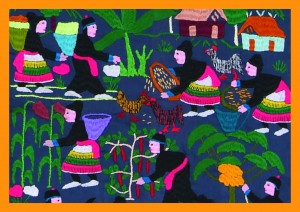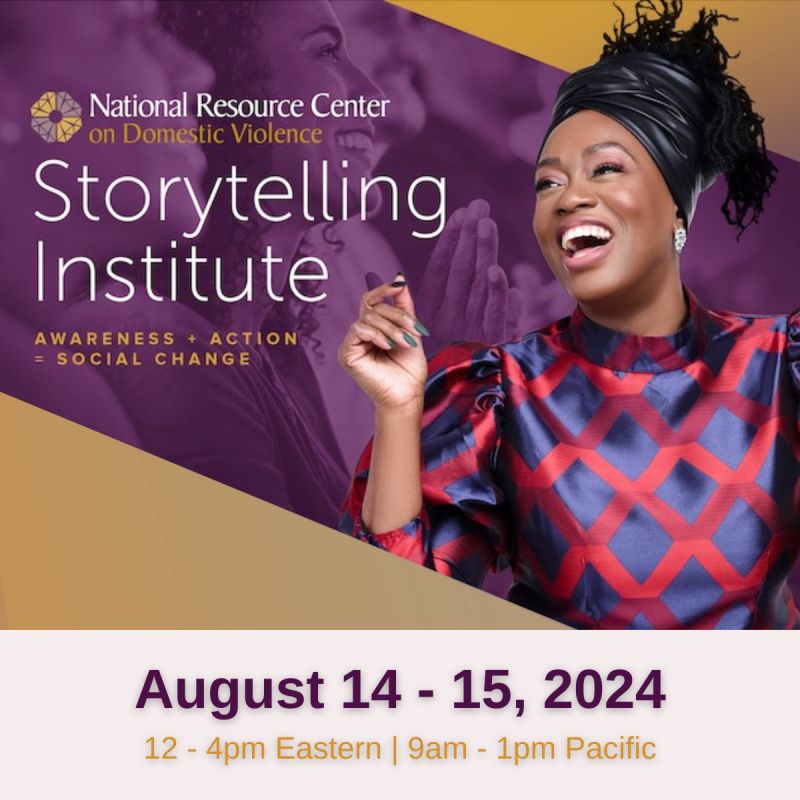By Patty Branco, Director of Training and Technical Assistance for the National Resource Center on Domestic Violence
“Storytelling is at the heart of what we do as advocates and movement builders. There’s a story behind why we started doing this work, a story that keeps us going, a story that connects us, and a story that will bring others along.” – Movement to End Violence
The telling of stories is in our human nature. From visual stories such as the cave paintings of prehistorical times, to oral stories passed down from generation to generation by word of mouth, to today’s digital stories, storytelling has always been a part of human interaction. Storytelling reflects who we are and allows us to record, share and make meaning of our lived experiences.
But what do we mean by stories? Stories are our personal accounts – “what we survived and how, what these experiences mean to us, and what we know now that we did not know before” (Blanch, Filson, Penney & Cave, 2012). Whether factual or fictional, sad or happy, personal stories are about one’s feelings, ideas, and perceptions about events. Combined, individual stories become the story of a people or a group, helping us understand the world. For example, the beautiful “story cloths” of Hmong women (pictured here) depict a story of collective trauma, representing these women’s experiences during the Vietnam War and their flight to Thai refugee camps.

Creating Unity & Inspiring Action
“Stories are for joining the past to the future. Stories are for those late hours in the night when you can't remember how you got from where you were to where you are. Stories are for eternity, when memory is erased, when there is nothing to remember except the story.” – Tim O’Brien, The Things They Carried (1998)
Our stories are powerful organizing forces that help to connect people despite cultural or geographical differences. They are the “basis for history, art, religion, politics, philosophy, and more, reflecting the ways in which we are uniquely separate, while revealing our interconnectedness” (Blanch, Filson, Penney & Cave, 2012). In this sense, storytelling is also the foundation upon which the movement to end gender-based violence has been built and sustained. The stories of survivors and advocates are the very threads that weave together our movement – at the local, state and national levels.
While storytelling, in and by itself, cannot solve the complex problem of gender-based violence, the telling and hearing of these stories play a critical role in promoting cultural transformation and propelling social change. For individual survivors – those who are ready and able to share their stories – storytelling can be an important part of healing from trauma (Story Center, n.d. Herman, 1997). But in addition to helping trauma survivors organize and reclaim control of their own experiences, storytelling has the power to deepen people’s understanding of gender-based violence. As survivors and advocates tell their stories, they raise awareness of the issue, 1) shedding light on its magnitude, 2) the societal barriers survivors and their children face when accessing help, and 3) opportunities to strengthen services and support for those in need.
Storytelling can be valuable in expanding narrowly conceived notions of what victims “are like” (Roeder, 2015). It can also help connect survivors in important ways to the larger intervention and prevention efforts in their community and across the country, as well as help make shifts in system responses and policies to better meet survivors’ needs (NRCDV, 2011).
Listening thoughtfully to the accounts of survivors and advocates can be a powerful way for all of us to stand with others in their pain and healing, struggles and triumphs. In this sense, the “trauma story” works not only to heal the survivor, “but also to teach and guide the listener – and by extension, society – in healing and survival” (Mollica, 2006). Hearing directly from survivors about their experiences and the impact of violence on their lives can inspire and energize others to act. “Sharing personal stories can communicate that it is possible to move beyond the circumstances of one’s life. It sends a message of hope: If you can, I can!” (Blanch, Filson, Penney & Cave, 2012).
Holding & Centering Marginalized Voices
“(…) the telling of our stories enables us to name our pain, our suffering and to seek healing.” – bell hooks, Sisters of the Yam (1993)
Whether shared across dinner tables or in a conference room, via visual arts or spoken words, stories from survivors and advocates can help create unity and inspire action, bringing individuals together to confront gender-based violence and other forms of oppression. Of particular importance in advancing our social justice work is creating space for and amplifying the voices of individuals from traditionally marginalized and oppressed groups, including Black, Indigenous, and People of Color (BIPOC) communities, non-English speakers, immigrants, Muslims, incarcerated survivors, Deaf people, people who are trans-identified, gender non-conforming, lesbian, gay, or bisexual, and people living with disabilities.
Because the history found in textbooks, mainstream media and “official records” is predominantly the narration of the dominant group – told by white, affluent, heterosexual, cisgender, able-bodied voices – storytelling has historically been a powerful tool for marginalized groups in naming their struggles, seeking healing and fostering social change and justice. For example, storytelling has been an integral part of the history of people of African descent. As Vanessa Jackson states: “From the griots of ancient African to the sometimes painful lyrics of hip-hop artists, people of African descent have known that our lives and our stories must be spoken, over and over again, so that the people will know our truth” (Jackson, n.d.).
Not only is storytelling effective in transforming stories of victimhood and oppression into stories of survival and inspiration for collective action, storytelling is also a tool that is accessible to everyone. As storyteller Rivka Willick reminds us, if we can communicate on whatever level, then we can tell a story. She also notes that we do not always have to look for our most dramatic or powerful story to tell: “Sometimes a very small story is tremendous and exactly what we need” (Willick, n.d.).
Additionally, practices such as participatory media and popular education can support the sharing of stories and voices that often go unspoken and unheard. More than ever, people everywhere are using digital media to tell meaningful stories from their lives. StoryCenter is an example of an organization supporting communities in using storytelling and participatory media for reflection, education, and social change. They offer case studies, articles, workshops, and more.
Join NRCDV’s Free Storytelling Institute!
“There is no greater agony than bearing an untold story inside of you.” – Maya Angelou
The National Resource Center on Domestic Violence’s Storytelling Institute is a free live two-day, virtual training set to take place on August 14 and August 15, 12:00pm-4:00pm (ET). This will be an amazing opportunity for individuals who seek to move their target audiences from facts and numbers to taking action, utilizing storytelling as a tool for social transformation. This interactive training will provide participants with a digital companion guide, along with strategies and frameworks to identify storytelling goals, build a story bank, develop storytellers within your organization and nurture a sustainable culture of powerful storytelling.
The Institute will be led by Mothyna James-Brightful. Affectionately known as Sister Mothyna, during her 16-year professional speaking career she has logged over 40,000 hours on stage. She has been described as “energetic, passionate and inspirational” by audiences. With four publications under her belt, she is the author of the Amazon Bestseller Engage. Inspire. Prevent.: Strategies for Educating Teens on Sexual Violence.
By the end of this training, you will learn how to:
- Identify how to find stories to tell and build a story bank
- Build rapport and make emotional connections through effective storytelling
- Identify and develop internal storytellers in your organization to maximize their role as change agents
- Apply industry best practices and vetted frameworks to craft compelling stories
- Nurture a sustainable culture of powerful storytelling in your organization
Tools and Resources to Support Your Storytelling Journey
 “If you are silent about your pain, they’ll kill you and say you enjoyed it.” – Zora Neale Hurston
“If you are silent about your pain, they’ll kill you and say you enjoyed it.” – Zora Neale Hurston
Still, we know that telling one’s story is often difficult, especially for trauma survivors. “Women who wish to make their stories of violation and abuse public are often met with retraumatizing reactions such as blame and doubt, rather than empathy and belief” (Roeder, 2015). Thoughtfully planning for survivors’ safety and overall wellbeing as they tell their stories is critical. As we lift up and honor the voices of survivors and advocates through storytelling, a variety of tools are available to support our collective efforts. Consider the following – lovingly curated – offerings to be your storyteller giftbox!
Guides & Toolkits
- The ABCs of Storytelling: This fun handout offers tips to nurture and inspire new and seasoned storytellers.
- From the Front of the Room: An Advocate’s Guide to Help Prepare Survivors for Public Speaking: This guide provides a basic overview of the issues that face survivors who desire to speak publicly about their experiences with intimate partner violence. It provides guidance for both the survivor speaker and victim advocates seeking to maximize the survivor’s physical and emotional safety and ensure the overall success of the speaking engagement. See also From the Front of the Room: A Survivor's Guide to Public Speaking and Quick Guide: From the Front of the Room – Tips for Survivor Speakers & Victim Advocates.
- From the Front of the Room: Sharing Your Childhood Story of Domestic Violence: This guide, designed for adult survivors, explores the power of storytelling and the unique value that stories of adult children exposed to domestic violence can bring to social change movements, offering guidance for 1) assessing readiness, 2) finding your voice, 3) clarifying your message, and 4) attending to your wellness. Considerations for speaking to key audiences are also included. See also Pocket Guide: Sharing Your Childhood Story of Domestic Violence.
- ACE-DV Speaker’s Toolkit: This Toolkit offers a variety of practical resources and tools to help build the capacity of adult survivors of children’s exposure to impact change through storytelling. Materials are accessible in a variety of formats to suit the diverse learning styles of this audience.
- Speaking out from Within: Speaking Publicly About Sexual Assault: This pamphlet provides guidance to survivors of sexual abuse who are considering speaking publically about their experiences.
- Telling Our Stories: Ending the Cycle of Shame: Creating room for stories can unveil the complex web of chains that trap TQLGB survivors in an unending cycle of shame. This resource from Intercambios proposes a shift in perspective. Instead of wondering why individuals from TQLGB communities are hesitant to share/disclose their stories, let’s redirect the focus inward and ask: “How might I or my agency be contributing to the narrative of shame?”
- The Accidental Public Speaker / El Orador Accidental: Have you been called on to speak publicly at an event but found yourself too nervous or scattered to engage the audience effectively and get your point across? Available in English and Spanish, this toolkit helps public speakers deliver a powerful speech while driving positive change in gender-based violence prevention and community engagement.
Webinars & Training Videos:
- Leveraging #1Thing in Your Community: Through this webinar, participants will learn ways to enhance their community engagement efforts, as well as understand the importance of including storytelling in their efforts by leveraging the #1Thing messaging.
- Digital Storytelling for Social Change: Domestic Violence Awareness Month and Beyond: In this introductory webinar, StoryCenter staff discusses the theoretical underpinnings, methods, and impacts of storytelling in domestic violence work and offers resources for organizations interested in developing storytelling efforts for DVAM and beyond.
- Using Story Circles to Capture Local Community Responses to Gender-based Violence During TDVAM and Beyond: This one-hour webinar for Teen Dating Violence Awareness Month introduces a simple, community-based process for sharing and capturing poignant personal stories of how young people are taking action.
- Beyond Single Stories: This virtual learning community explores the dangers of “single stories.” Through storytelling of how “single stories” have harmed us to a how the implicit bias that is fueled by one-dimensional narratives pervades our systems and institutions, even in programs that are trying to do good. They remind us that single stories and implicit bias serve to maintain systems of power and oppression and that it’s up to all of us to expand the narrative and recognize our biases so that we can interrupt violence and build our collective power.
- Chimamanda Ngozi Adichie: The danger of a single story | TED: Our lives and cultures are composed of many overlapping stories. Novelist Chimamanda Adichie tells the story of how she found her authentic cultural voice – and warns that if we hear only a single story about another person or country, we risk a critical misunderstanding.















